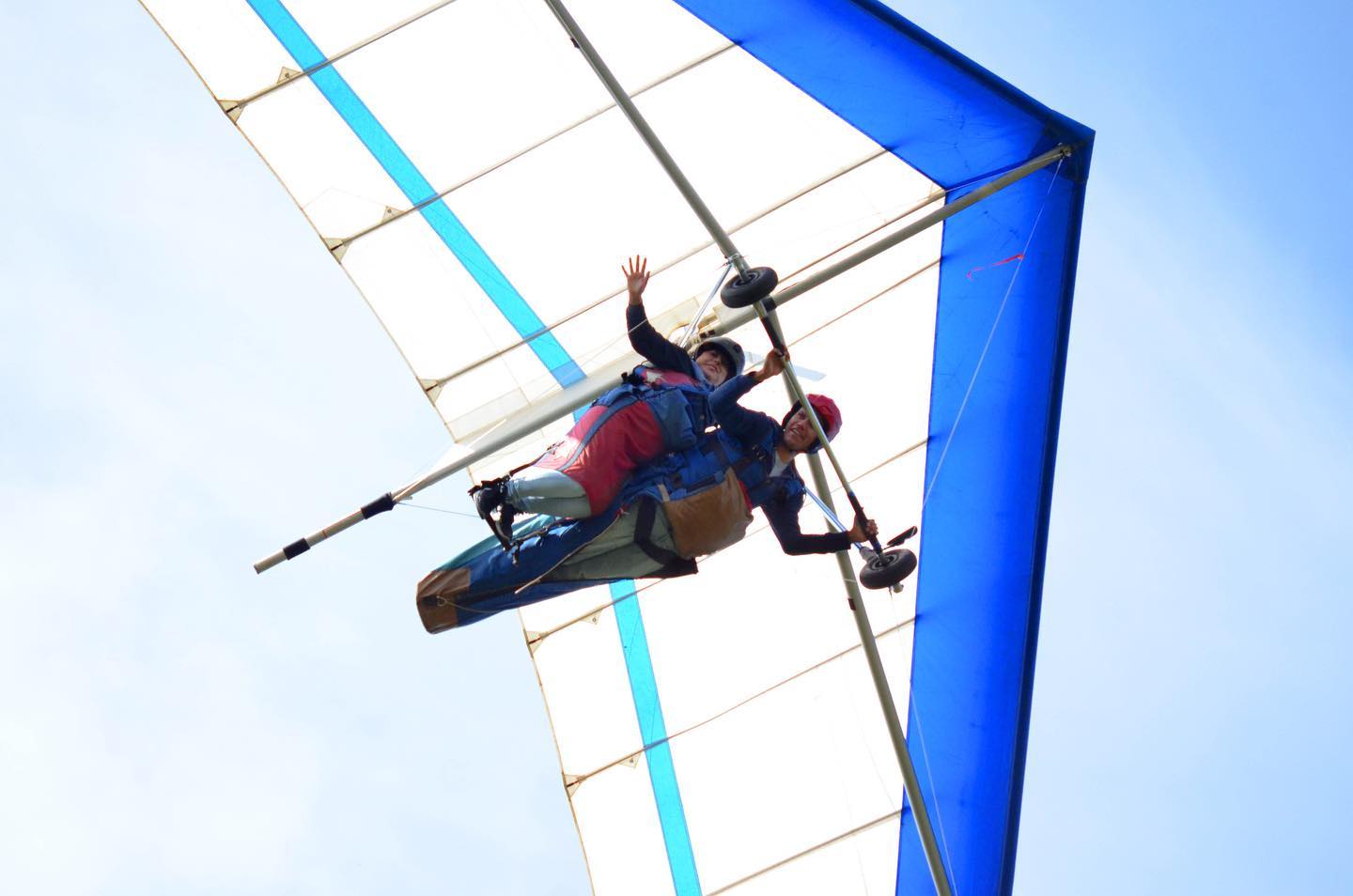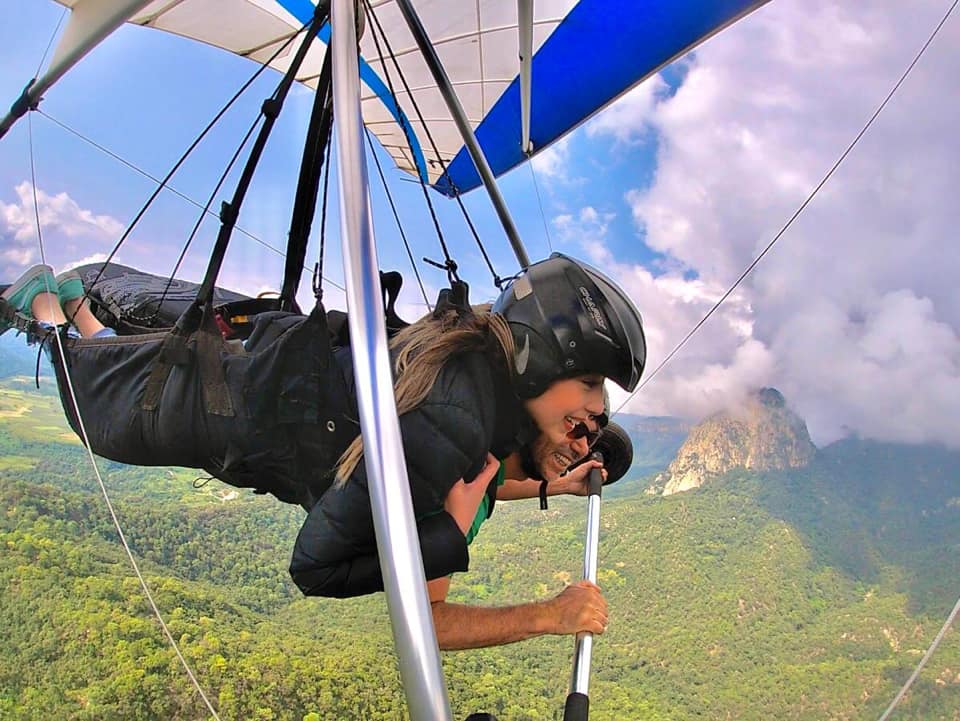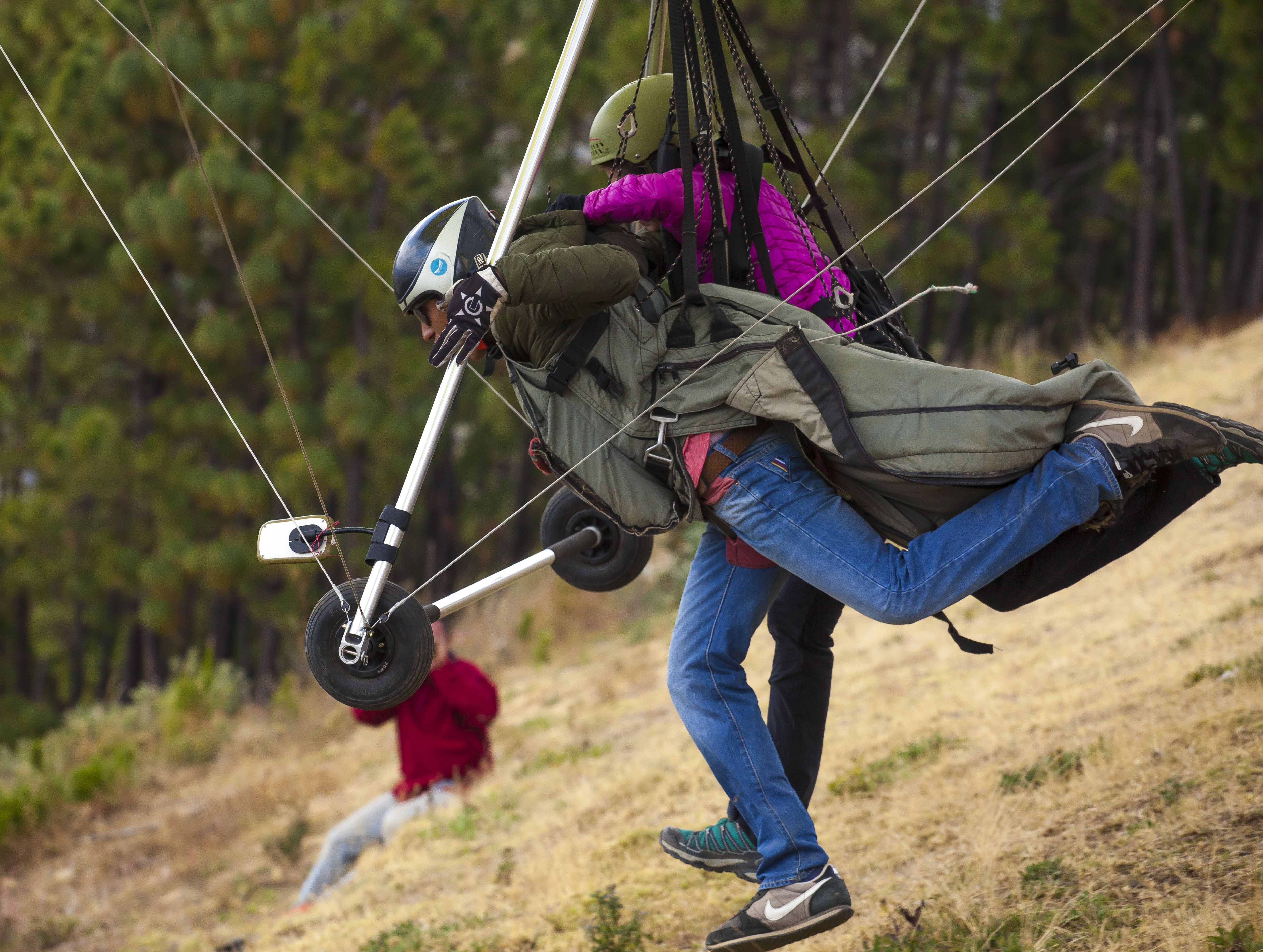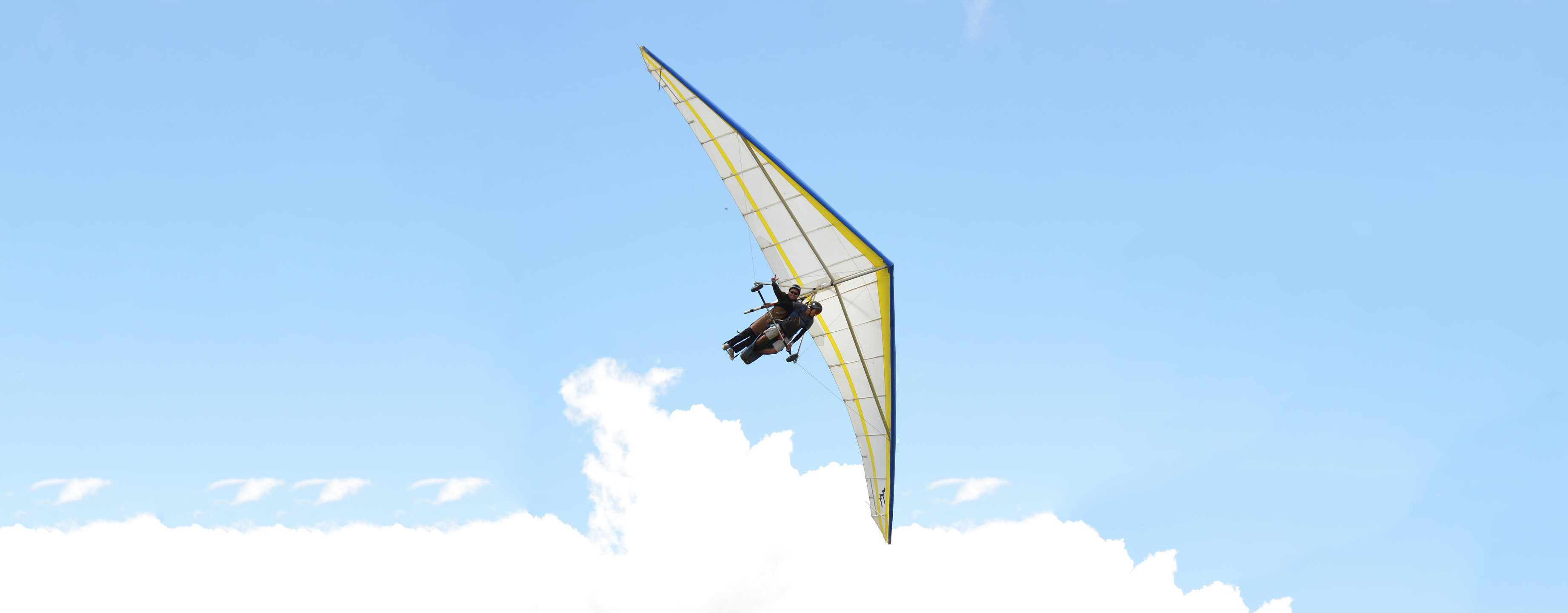FALCON 4 TANDEM
The Falcon 4 Tandem is our glider designed to make the 2-passenger flight possible, featuring stiffer and lighter 7075-T6 leading edge spars, With the Falcon 4 Tandem can be used in aerotow and foot-launch operations and has been evaluated and endorsed by top professionals from Lookout Mountain Flight Park to Rio de Janeiro.
"After about 200 flights on it, I must state: It’s the best tandem glider ever! Lighter built than the F3T it’s superior to the previous version in all aspects, performing outstandingly with heavy loads at foot launching and landing. Thanks Steven Pearson!" -Konrad Heilman, Rio Hang Gliding
"You’ll fall in love with it very quickly. Lighter, stiffer 3 part leading edge, turns flatter and lighter bar pressure. Goes up like a rocket." -Ian Clark, Rio Hang Gliding

The Falcon 4 Tandem has an especially robust and wide control bar that comfortably accommodates the instructor and student and a heavy duty trailing edge panel with our strongest and most durable woven fabric 240MT. The airframe and sail design combine to produce a glider with exceptional load carrying capacity, that slows down extremely well and retains excellent handling qualities across a hook in weight range from 185 lbs to 550 lbs.


- Refined planform and sail cut for increased load capacity
- The stiffest and lightest leading edges that we’ve ever incorporated in a production airframe Front leading edge is 60/62mm 7075-T6 with 50mm 7075-T6 rear leading edge
- Trailing edges speed battens to reduce flutter and improve sail life are standard
- Heavy duty control bar fittings and keel interface bracket, exclusively for the Tandem
- Super strong 50 / 52mm 7075-T6 Keel
- 1.25 x .095 control bar downtubes (25% stronger than AT68)
- 1.25 x .095 control bar basetube (70% stronger than standard)
- 64 in wide basetube (8 in wider than AT68 basetube)
- 240 MT Square trailing edge fabric
- Laminate sail options are available for Panel 1 or Panels 1/2/3/4 (the entire top surface)
- 7075 – T6 Pre-formed Battens
- Lever Rear Batten Tips
- Full Leading Edge Pocket (Dacron) and Mylar Insert
- Streamlined Kingpost
- Comprehensive Owner and Batten Diagram
GLIDER RETAIL PRICE: $5,750.00 USD
| ID # | Description | Suggested Retail Price USD |
|---|---|---|
| 01A-A2 | P1 UPGRADE 170 TO 205MT | $ 210.00 |
| 01A-A29 | P1 UPGRADE 170 TO MYLAR LAMINATE | $ 225.00 |
| 01A-A30 | P1 UPGRADE MYLAR LAMINATE TO TECHNORA LAMINATE | $ 310.00 |
| 01A-A37 | P3 AND P4 UPGRADE 170 TO MYLAR LAMINATE | $ 530.00 |
| 01A-A43 | FALCON P1, P2, P3 AND P4 UPGRADE TO UVODL04/06 | $ 1,185.00 |
| 01A-A55 | FALCON MYLAR LAMINATE SAIL UPGRADE P1, P2, P3 AND P4 | $ 800.00 |
| 01A-A813 | MONARCH BOTTOM SURFACE OPTION | $ 430.00 |
| 01A-A83 | COLORED SAIL PATCHES | $ 200.00 |
| 01A-A84 | COLORED BATTEN POCKETS | $ 250.00 |
| 01A-A85 | SEW SAIL WITH BLACK THREAD | $ 200.00 |
| 45J-0001 | HANG LOOP UPGRADE DHV | $ 20.00 |
| 45J-0002 | HANG LOOP UPGRADE CUSTOM | $ 20.00 |
| 90G-2150 | GLIDER BREAKDOWN (ONLY) | $ 60.00 |
| 90G-2410 | GLIDER BREAKDOWN AND BOX | $ 100.00 |
From 10/18/2023
Some options may be incompatible with others. See your Wills Wing dealer for details.
Metric Units
| Specification | Falcon 4 Tandem |
|---|---|
| Area (m^2) | 21.2 |
| Span (m) | 10.9 |
| Aspect Ratio | 5.6 |
| Glider Weight (kg) | 32.2 |
| Hook-In Weight (kg) | 84-250 |
| Optimum Body Weight (kg) | 100-216 |
| USHPA Rating | 2 |
| Vne (kph) | 80 |
| Va (kph) | 69 |
| Vms (kph) | 26 |
| Vd (kph) | 56 |
| Length (in bag) (m) | 6.42 |
| Break-down (m) | 3.96 |
| HGMA Certified | Mar 21, 2016 |
United States Customary Units
| Specification | Falcon 4 Tandem |
|---|---|
| Area (ft^2) | 228 |
| Span (ft) | 35.8 |
| Aspect Ratio | 5.6 |
| Glider Weight (lbs) | 71 |
| Hook-In Weight (lbs) | 185-550 |
| Optimum Body Weight (lbs) | 220-475 |
| USHPA Rating | 2 |
| Vne (mph) | 50 |
| Va (mph) | 43 |
| Vms (mph) | 16 |
| Vd (mph) | 35 |
| Length (in bag) (in) | 253 |
| Break-down (in) | 156 |
| HGMA Certified | May 21, 2016 |
9/14/2015 Ben Herring
Hi folks,
Mark at Airtime Above mentioned that I’m one of the early recipients of the F4 Tandem so I wanted to share some feedback (all good) with you on my experiences with it so far. And first of all, THANK YOU for hooking me up with the latest model!
So I’m a newer tandem pilot with around 150-200 commercial tandem flights. 50/50 aerotow to foot launch ratio. Tandem flights that I’ve been “Pilot in Command” for were almost exclusively with my F2 tandem although I’ve also used an F3, and an Atos VX. My lizard brain this year is exclusively dialed into my F2, foot launching from 7,000 ft MSL. Foot Launching – I’ve really enjoyed significantly less bar pressure when standing on launch, and throughout the launch run. I had thought my first launch was weak since I came off the hill without the usual grunting-level bar pressure but now after about 10 flights, my lizard brain has adjusted and I really appreciate the lighter feel. Like with flying, a light touch gives me a better “feeling” of the glider and all my tandem F4 launches so far have been very confidence inspiring. Even with higher weight passengers than I would previously allow.
Since these F4 launches have been so great, I’m considering expanding my max foot launch weight from 165 lb passengers to 175-180 which will really expand customer base. On Saturday the F4 helped me take one of the heaviest passengers I’ve foot launched, several thousand feet up to circle with the real birds which made my day as much as it did the passengers! So far, my F4 foot launch hook-in weights have been between 180 lbs (just me) and 375 lbs. In my solo test flight, I felt like she wasn’t as responsive as my older F2 (which makes total sense in new vs. old). Maybe she will loosen up for solo flying although I realize I’m asking a lot since it’s not what she was designed for. Anyway, with only a 100 lb passenger, the glider feels perfectly responsive and compliant circling reasonably close into the hill. Landing – I land on the wheels up here in a very small LZ (Lookout Mtn in Golden, CO). At the highest speeds, the F4 retains more energy when compared to my older F2! I can still put it on the spot but it’s noticeable when I do a big banked turn onto final with pull in to really get the speed up and burn down into the LZ. I may adjust my approach tactics a little bit in this regard. I’m excited for the future with this wing and feel that the F4 has increased the safety margins for my foot launches here in Colorado. As a tandem pilot, safety is everything and I appreciate Wills wing for always improving and making this great wing even better!
Thank you!
Onward and Upward,
Ben Herring | 303-513-0998
http://www.hangglidecolorado.com
https://www.facebook.com/HangGlideColorado
11/21/2015 Mark Vanderwerf
The new Falcon IV Tandem is a combination of a hand full of small changes that add up to a noticeably improved glider. Out of the bag the obvious three changes are the addition of a baton per side (increased baton density), two speed batons per side and beefier leading edges. Having owned three Falcon III Tandems and worked commercially on an additional other four over the past 7 years I can confidently say that the new Falcon IV is a notably improved wing. The primary complaint I’ve heard over the years from other pilots about the Falcon III Tandem is it’s heavy handedness… large amount of effort in both pitch and roll control needed to fly the glider. The Falcon IV has noticeably lighter pitch and roll. It also has a noticeably larger speed range. It likes to fly slower and maintains easy roll control at low speeds. It also accelerates and maintains higher speeds better. The main thing I’m stoked on about the new Falcon IV Tandem is the flair window. The Falcon III had been my choice over other tandem wings for quite sometime due to the large flair window and predictable flair characteristics. The new Falcon IV with it’s greater baton density has an even larger flair window with a noticeably softer/ easier push back from the control frame. I have not yet had the chance to Aero-Tow the Falcon IV tandem but guess with it’s now 550 lbs. placarded max hook-in weight will fast become the new industry standard for the go to tandem glider of choice.
Retail prices listed are Wills Wing's suggested retail prices not including packaging for shipment from the factory, freight costs to the destination, import and local taxes, and dealer preparation and delivery charges. Read more …
